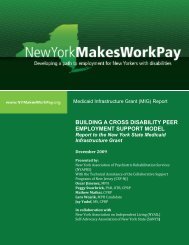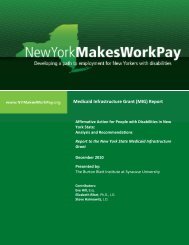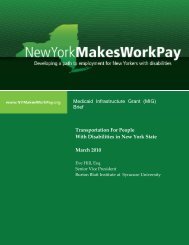Disability & Employment Law in New York State - Cornell University
Disability & Employment Law in New York State - Cornell University
Disability & Employment Law in New York State - Cornell University
You also want an ePaper? Increase the reach of your titles
YUMPU automatically turns print PDFs into web optimized ePapers that Google loves.
<strong>Disability</strong> & <strong>Employment</strong> <strong>Law</strong> <strong>in</strong> <strong>New</strong> <strong>York</strong> <strong>State</strong>:Analysis and RecommendationsAdditionally, employers, labor organizations and employment agencies may be heldresponsible for discrim<strong>in</strong>ation <strong>in</strong> access or admission to tra<strong>in</strong><strong>in</strong>g or apprenticeshipprograms, or if reasonable accommodations are denied with<strong>in</strong> those programs. 68D) DefensesNYSHRL provides an “undue hardship” defense to the requirement to providereasonable accommodations:(b) Noth<strong>in</strong>g conta<strong>in</strong>ed <strong>in</strong> this subdivision shall be construed to requireprovision of accommodations which can be demonstrated to impose anundue hardship on the operation of an employer’s … bus<strong>in</strong>ess,program or enterprise. In mak<strong>in</strong>g such a determ<strong>in</strong>ation with regard toundue hardship the factors to be considered <strong>in</strong>clude:(i) The overall size of the bus<strong>in</strong>ess, program or enterprise with respectto the number of employees, number and type of facilities, andsize of budget;(ii) The type of operation which the bus<strong>in</strong>ess, program or enterprise isengaged <strong>in</strong>, <strong>in</strong>clud<strong>in</strong>g the composition and structure of theworkforce; and(iii) The nature and cost of the accommodation needed. 69The mean<strong>in</strong>g of undue hardship under the NYSHRL is similar to federal disability law,focus<strong>in</strong>g on the nature and cost of the accommodation, the type and nature of the workthe employer performs, and the size and organizational budget of the employer. 70 For<strong>in</strong>stance, accommodations are less likely to be considered reasonable if they are verycostly relative to the organizational budget, or require drastic changes to theorganizational structure or purpose. Accommodations that alter specific policies ornorms for <strong>in</strong>dividuals with disabilities, but which do not significantly affect the wholestructure of the workplace or its purpose, likely will be found reasonable. 71While the ADA conta<strong>in</strong>s explicit statutory language establish<strong>in</strong>g what defenses willexcuse an employer from liability for discrim<strong>in</strong>atory action, the NYSHRL is not similarlyconstructed. The ADA provides that deny<strong>in</strong>g a job or benefit to a person with a disabilitybased on qualification standards can be found lawful where it is “job-related andconsistent with bus<strong>in</strong>ess necessity.” 72 Although the NYSHRL does not discuss defensesas such, relatively similar outcomes are achieved, <strong>in</strong> that a pla<strong>in</strong>tiff has the burden ofestablish<strong>in</strong>g that s/he can perform the normal job functions, with or withoutaccommodation.68 N.Y. Exec. <strong>Law</strong> §§ 296(1)-a).69 N.Y. Exec. <strong>Law</strong> § 296(3)(b).70 Id.71 See, e.g., Krikelis v. Vassar College, 581 F.Supp.2d 476 (S.D.N.Y. 2008) (hold<strong>in</strong>g that a policy aboutthe structure of employee breaks should be modified to accommodate the needs of a diabetic employeewho needed to eat more frequently).72 ADA, 42 U.S.C. § 12113(a).12





